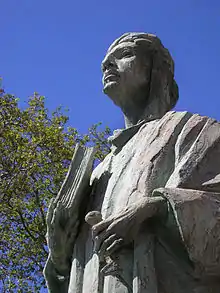Statue of Almanzor, Algeciras
The Statue of Almanzor is a 2002 statue depicting the medieval Islamic Spanish ruler Almanzor. It originally sat in what are now believed to be Christian ruins in the southern Spanish city of Algeciras. It was removed in 2013 and has yet to be reinstalled.
| Statue of Almanzor in Algeciras | |
|---|---|
 The statue in April 2009 | |
| Artist | Mariano Roldán |
| Year | 2002 |
| Medium | Bronze |
| Location | Algeciras, Andalusia, Spain |
Design
The statue was the winning design in a competition. It is a modernist style statue made of bronze, and depicts Almanzor with a Quran in his right hand and a sword in the left.[1]
Alberto Pérez de Vargas, a professor at Complutense University,[2] said that "it would be difficult to find a qualifier that has not been applied to [Almanzor]; from 'Islam's El Cid' to 'The Beast', going through everything imaginable for good or evil".[3] He organised raids against the Christian states of northern Spain, where his armies destroyed cities and took slaves.[4][5]
History
The statue was erected in Algeciras, Andalusia, Spain in 2002. Designed by Mariano Roldán, it was installed in ancient ruins on the one-thousandth anniversary of the death of Almanzor, a military leader of Islamic Spain and seen as one of the greatest leaders of Al-Andalus.[3] It was originally located in the Marinid Walls of Algeciras before being removed for restoration.[6]
In August 2013, the Algeciras City Hall, governed by the right-wing People's Party, removed the statue in order to repair its patina and complete other restorations. The local Deputy for Culture, Pilar Pintor, said that it would be removed to a more historically relevant location after the original location, once thought to be archeological remains of an Islamic site, was re-assessed as Christian ruins. An ancient kiln, discovered in these ruins several years prior, was to be placed at the statue's original site, with the local council explaining that it signified the importance of ceramics in Algeciras' history.[1]
In November 2016, with no update on the restoration of the statue, the matter was brought up in the City Hall by Leonor Rodríguez, a council member from the left-wing party Podemos. She accused the local government of hiding history.[6] The following June, the statue was found covered in a sheet in a warehouse; Socialist Workers' Party councillor Fran Fernández accused the PP of not looking after local heritage.[7]
As of August 2020, the statue is still not on public display.[3]
See also
References
- "Trasladan la estatua de Almanzor para su restauración" [Statue of Almanzor moved for restoration] (in Spanish). Algeciras al Minuto. 21 August 2013. Archived from the original on 1 September 2020. Retrieved 4 August 2020.
- "Pérez de Vargas anuncia un pregón de "Algeciras - entremares" rico en historias y algo novelado" [Pérez de Vargas announces a proclamation of "Algeciras - between seas", rich in stories and novelised] (in Spanish). Ayuntamiento de Algeciras. 19 August 2014. Archived from the original on 1 September 2020. Retrieved 4 August 2020.
- Pérez de Vargas, Alberto (2 August 2020). "Almanzor, el del pico" [Almanzor, him of the peak] (in Spanish). Europa Sur. Archived from the original on 3 August 2020. Retrieved 4 August 2020.
- Pérez de Tudela y Velasco, María Isabel. "Guerra, violencia y terror: La destrucción de Santiago de Compostela por Almanzor hace mil años" [War, violence and terror: The destruction of Santiago de Compostela by Almanzor a thousand years ago]. En la España Medieval (in Spanish). Madrid: Complutense University. 21: 9-28.
Barcelona quedaba sola ante su enemigo y el 6 julio del 985 fue tomada al asalto, saqueada y quemada. La mayor parte de sus habitantes fueron pasados a cuchillo y el resto vendidos como esclavos [Barcelona remained alone against its enemy and on 6 July 985 it was assaulted, sacked and burned. Most of its inhabitants were put to the sword and the rest sold as slaves].
- "Enric Calpena: La razia de Almanzor tuvo un impacto positivo en Barcelona" [Enric Calpena: Almanzor's raid had a positive impact on Barcelona]. La Vanguardia (in Spanish). 10 November 2018. Archived from the original on 1 September 2020. Retrieved 4 August 2020.
"No hubo una destrucción total, como se había mantenido, pero la ciudad recibió un golpe muy fuerte, y además Almanzor hizo miles de esclavos, buena parte de los cuales subastó cerca de Martorell y los que no consiguió vender o cobrar el rescate, se los llevó a Córdoba". ["It wasn't a total destruction, like it has been believed, but the city received a very hard blow, and in addition Almanzor took thousands of slaves, a good part of which he auctioned off near Martorell and those that he couldn't sell or ransom, he took them to Córdoba]
- "Podemos pide que vuelvan a colocar la estatua del sanguinario caudillo musulmán Almanzor" [Podemos asks for the statue of the bloodthirsty Muslim general Almanzor to be put back up] (in Spanish). Hora Sur. 28 November 2016. Archived from the original on 8 August 2017. Retrieved 4 August 2020.
- "El PSOE acusa al Gobierno de Landaluce de no cuidar el patrimonio" [PSOE accuses Landaluce's Government of not looking after heritage] (in Spanish). Cadena SER. 14 June 2017. Archived from the original on 28 October 2017. Retrieved 4 August 2020.
External links
![]()